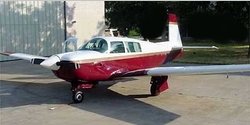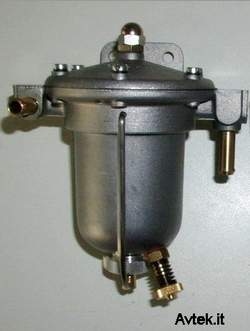Tried to Fly a (Temporarily) Steam-Powered Mooney. Didn't
Succeed.
 This fellow hadn't experienced troubles like this
before, so he didn't check... and so he had the trouble. The UK's
AAIB donated this nugget of insight to the aviation
community:
This fellow hadn't experienced troubles like this
before, so he didn't check... and so he had the trouble. The UK's
AAIB donated this nugget of insight to the aviation
community:
The owner of the aircraft [a 1989 Mooney M-20J (file
photo)] was undergoing a Licence Proficiency Check. He had
completed the external checks and was then joined in the aircraft
by the examiner, who was the legal commander of the aircraft. The
owner indicated to the examiner that the external checks had been
completed satisfactorily. After engine start, the aircraft, with
the owner as the handling pilot, was taxied to the holding point
for Runway 24 and the power checks were completed with no
indication either on the engine instruments or aurally of any
malfunction. After completing the pre-takeoff vital actions, the
takeoff run was commenced with the engine instruments indicating
that the engine was developing full power and with the aircraft
accelerating normally.
 After
takeoff, at a height estimated by the examiner to be approximately
100 to 150 feet agl, the engine suffered a sudden very severe power
loss. Prior to the power loss there were no other symptoms, such as
rough running or misfiring. The aircraft pitch was adjusted to
adopt the ideal glide attitude and to maintain a safe airspeed.
With the owner continuing to act as the handling pilot, the
appropriate actions for an engine failure after takeoff were
carried out. The examiner transmitted a truncated
‘Mayday’ call... There was no fire. The aircraft was
secured and the two pilots exited without difficulty.
After
takeoff, at a height estimated by the examiner to be approximately
100 to 150 feet agl, the engine suffered a sudden very severe power
loss. Prior to the power loss there were no other symptoms, such as
rough running or misfiring. The aircraft pitch was adjusted to
adopt the ideal glide attitude and to maintain a safe airspeed.
With the owner continuing to act as the handling pilot, the
appropriate actions for an engine failure after takeoff were
carried out. The examiner transmitted a truncated
‘Mayday’ call... There was no fire. The aircraft was
secured and the two pilots exited without difficulty.
...both tanks were found to be full of fuel. The fuel line
between the engine driven fuel pump and the fuel injector was
disconnected and a large quantity of water was drained out.
The aircraft had been parked in the open at Fairoaks for a
number of months. On 1 May 2002, it had been flown by the examiner
from Fairoaks to Bournemouth; a flight time of 45 minutes. 95
litres of Avgas 100LL had been uplifted the same day. On 10 May
2002, it was flown back to Fairoaks. On 19 June, a local flight of
one hour duration was made without incident. On the day of the
accident, the owner had made a telephone call to the airfield,
asking that G-MUNI be refuelled. 166 litres of Avgas 100LL was
uplifted, and this appeared to fill the tanks to capacity (32 USG
per tank). On the same day there was a period of very heavy
rainfall. [The accident occurred July 6 --ed.] Over this whole
period the aircraft had been parked in the open...
 The
aircraft has fuel drains in each tank and the gascolator. The
latter is operated by a pull ring inside the cockpit, located under
the front edge of the left front seat. This drain operating ring is
not readily visible when the seat is not fully aft. From the
gascolator, the fuel passes to an electric fuel pump and then to
the engine driven fuel pump.
The
aircraft has fuel drains in each tank and the gascolator. The
latter is operated by a pull ring inside the cockpit, located under
the front edge of the left front seat. This drain operating ring is
not readily visible when the seat is not fully aft. From the
gascolator, the fuel passes to an electric fuel pump and then to
the engine driven fuel pump.
The design of the gascolator fuel drain, in common with similar
systems on some other light aircraft, is such that it is difficult
to check without assistance. If alone, the pilot must enter the
cockpit to operate the drain and ideally place a suitably bonded
container beneath the drain to collect the fluid. The pilot would
then have to wait for the contents to settle before being able to
positively identify whether it was fuel, water, or a mixture of
both. Being centrally placed, this drain is the lowest of the three
fuel drains, however it is also the easiest to overlook.
The owner stated that he had carefully carried out checks of the
wing drains, as these are at the lowest point of the tanks and
would therefore provide the first indication of any water in the
system. The fuel system draws fuel from the tanks slightly above
this level, to avoid drawing any small quantities of water into the
fuel lines. The owner normally checked the gascolator drain every
other flight or so, because it was both difficult and unlikely, in
his opinion, to contain water if the tank drains were clear of
water. He had owned the aircraft since 1993 and over that time, had
rarely found evidence of water in the fuel system drains, and then
only in minute quantities. [Note: the report says this pilot had
"7,240 hours (of which 10 were on type)," yet it also says he owned
the aircraft since 1993 --ed.]
 Aero-News: Quote of the Day (12.07.25)
Aero-News: Quote of the Day (12.07.25) ANN's Daily Aero-Linx (12.07.25)
ANN's Daily Aero-Linx (12.07.25) NTSB Final Report: Lafferty Jack Sea Rey
NTSB Final Report: Lafferty Jack Sea Rey Classic Aero-TV: The B29 SuperFortress Doc - History in Flight
Classic Aero-TV: The B29 SuperFortress Doc - History in Flight Airborne 12.08.25: Samaritans Purse Hijack, FAA Med Relief, China Rocket Fail
Airborne 12.08.25: Samaritans Purse Hijack, FAA Med Relief, China Rocket Fail





